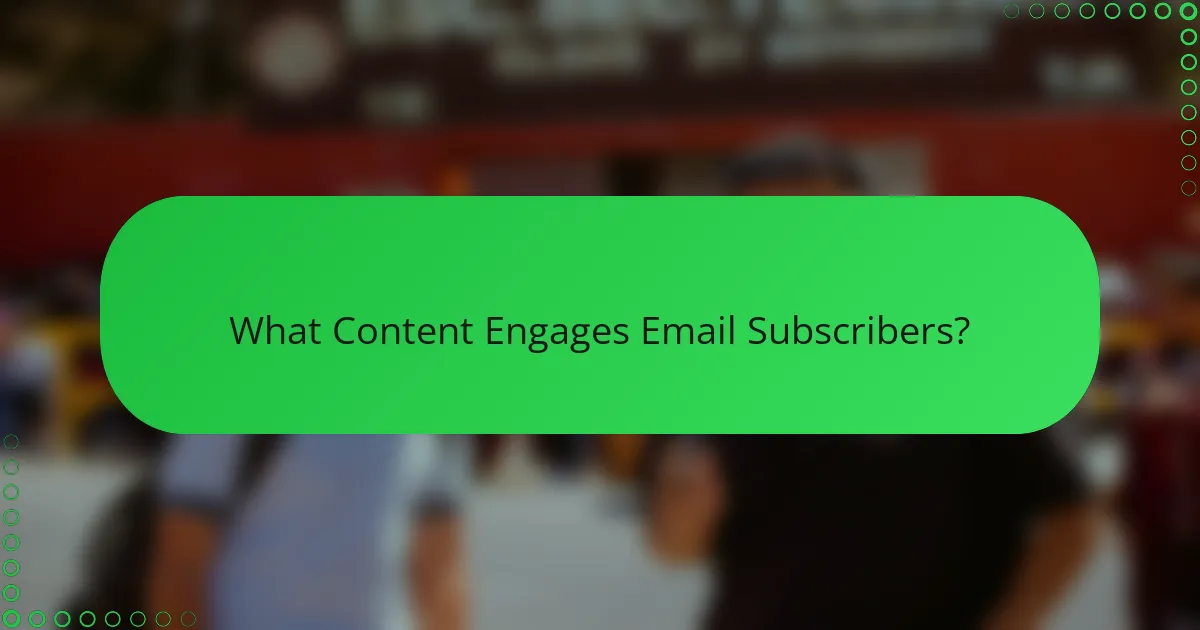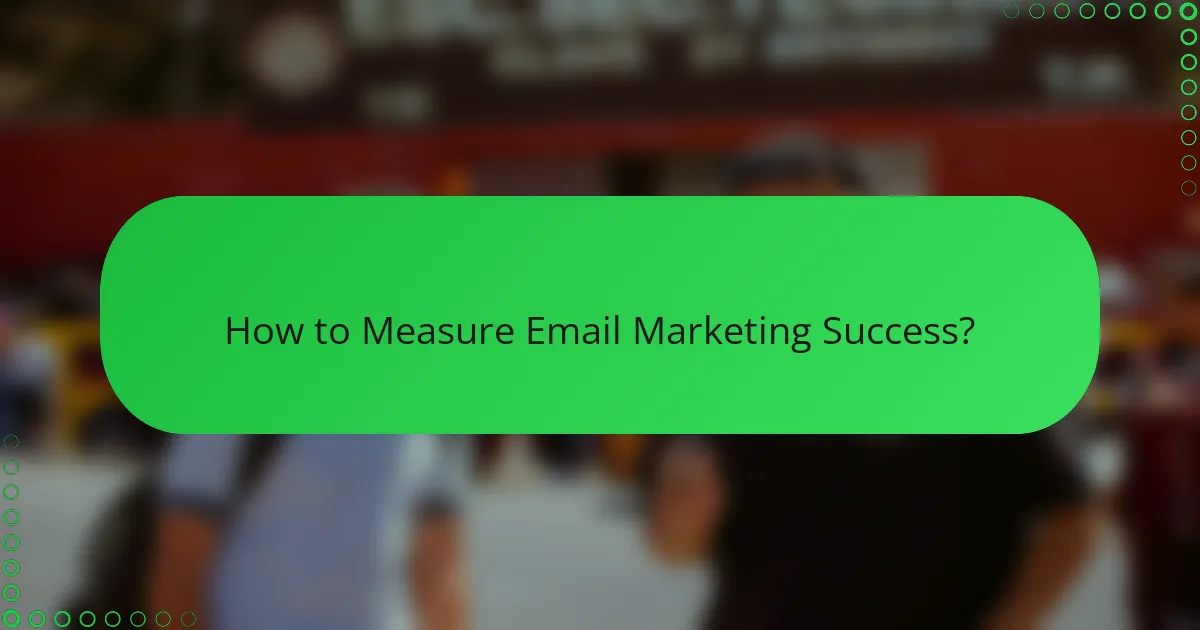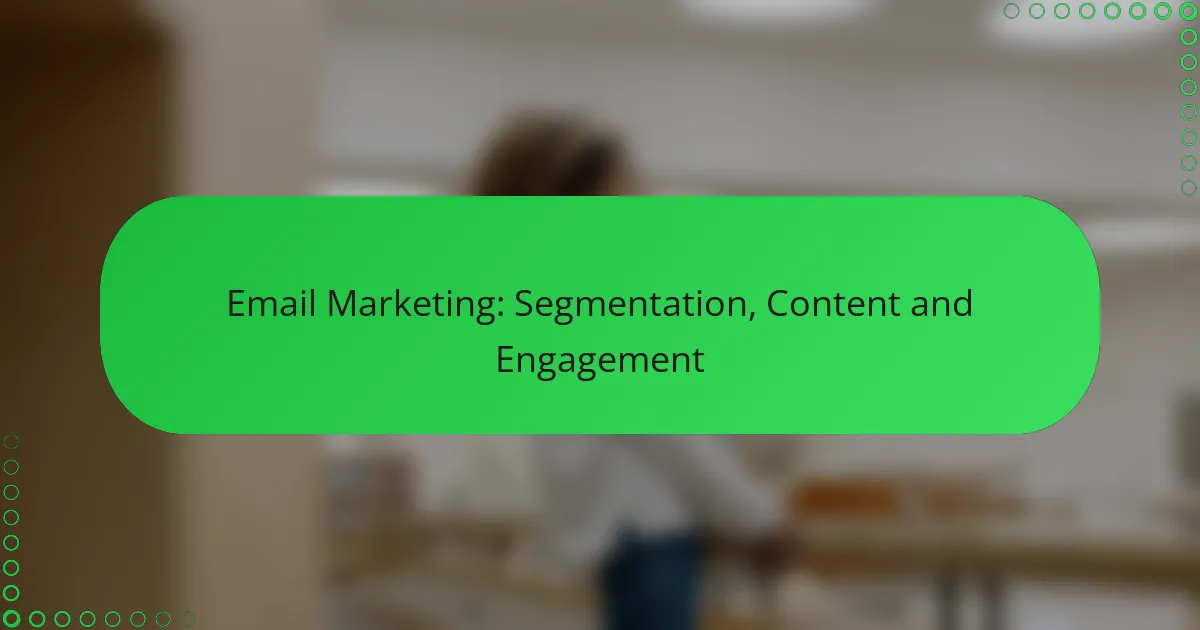Email marketing thrives on the principles of segmentation, tailored content, and active engagement. By dividing your audience into specific groups, you can deliver personalized and relevant messages that resonate with their interests. This targeted approach not only enhances engagement but also boosts the effectiveness of your campaigns, leading to improved open and click-through rates.

How to Segment Your Email List Effectively?
Effective email list segmentation involves dividing your audience into distinct groups based on shared characteristics. This targeted approach enhances engagement and improves the relevance of your content, leading to better overall campaign performance.
Demographic segmentation
Demographic segmentation categorizes your email list based on characteristics such as age, gender, income, and education level. For example, a fashion retailer might send different promotions to younger customers compared to older ones, tailoring the messaging to each group’s preferences.
When implementing demographic segmentation, ensure you collect accurate data through sign-up forms and surveys. This information allows for more personalized content, which can significantly boost open and click-through rates.
Behavioral segmentation
Behavioral segmentation focuses on how subscribers interact with your emails and website. This includes their purchase history, email engagement, and browsing behavior. For instance, customers who frequently open emails but rarely make purchases might benefit from targeted offers to encourage conversions.
Utilizing behavioral data helps you create tailored campaigns that resonate with specific actions. For example, sending a follow-up email with a discount to users who abandoned their shopping carts can effectively drive sales.
Geographic segmentation
Geographic segmentation divides your audience based on their location, such as country, region, or city. This approach is particularly useful for businesses with location-specific products or services. For example, a restaurant chain might promote different menu items based on regional tastes.
Consider local holidays and events when crafting your messages. Tailoring content to align with geographic factors can enhance relevance and engagement, making your emails more appealing to recipients.
Psychographic segmentation
Psychographic segmentation categorizes subscribers based on their interests, values, and lifestyles. This method allows for deeper personalization, as it considers the motivations behind consumer behavior. For instance, a travel agency might target adventure seekers with thrill-seeking vacation packages.
To implement psychographic segmentation, gather insights through surveys or social media interactions. Understanding your audience’s preferences can lead to more compelling content that resonates on a personal level.
Using tools like Mailchimp for segmentation
Mailchimp offers robust segmentation features that allow you to create targeted lists based on various criteria. You can easily filter subscribers by demographics, behaviors, and engagement levels, making it simple to send tailored campaigns.
To maximize Mailchimp’s segmentation capabilities, regularly update your audience data and test different segments. This practice helps you refine your strategies and improve overall campaign effectiveness, ensuring your emails reach the right people with the right message.

What Content Engages Email Subscribers?
Engaging email content is tailored to the interests and preferences of subscribers, making them feel valued and understood. Effective content strategies include personalization, interactivity, value-driven offers, storytelling, and continuous optimization through A/B testing.
Personalized content
Personalized content involves customizing emails based on subscriber data, such as demographics, past purchases, and browsing behavior. This approach increases relevance and can lead to higher engagement rates. For instance, using a subscriber’s name in the subject line or recommending products based on previous purchases can significantly enhance the email’s appeal.
To implement personalization effectively, segment your audience into distinct groups and tailor content accordingly. Tools like dynamic content blocks can help display different messages to different segments within the same email.
Interactive elements
Interactive elements, such as polls, quizzes, and clickable images, can significantly boost subscriber engagement. These features encourage recipients to participate actively rather than passively consuming content. For example, a quiz about product preferences can not only engage users but also provide valuable insights into their interests.
When incorporating interactive elements, ensure they are mobile-friendly and easy to use. Test the functionality across different devices to maximize accessibility and user experience.
Value-driven offers
Value-driven offers, such as discounts, exclusive content, or free trials, provide tangible benefits that can entice subscribers to engage with your emails. Highlighting these offers prominently can increase open and click-through rates. For example, a limited-time discount on popular products can create urgency and prompt immediate action.
To maximize effectiveness, clearly communicate the value of the offer and include a strong call to action. Consider using countdown timers to emphasize urgency and encourage quicker responses.
Storytelling techniques
Storytelling techniques can create an emotional connection with subscribers, making your content more memorable. By sharing relatable stories or customer testimonials, you can illustrate the benefits of your products or services in a compelling way. For instance, a narrative about how a product solved a customer’s problem can resonate deeply with potential buyers.
To effectively use storytelling, focus on authenticity and relatability. Keep the stories concise and relevant to your audience’s interests, ensuring they align with your brand message.
Using A/B testing for content optimization
A/B testing involves comparing two versions of an email to determine which performs better in terms of engagement metrics. This method allows marketers to refine their content based on real subscriber behavior. For example, testing different subject lines or call-to-action buttons can reveal what resonates most with your audience.
To conduct A/B tests effectively, isolate one variable at a time and ensure a sufficient sample size for reliable results. Analyze the data to inform future email strategies and continuously improve engagement rates.

What Are the Best Practices for Email Engagement?
Effective email engagement hinges on understanding your audience and delivering relevant content. By optimizing various elements of your emails, you can significantly improve open rates, click-through rates, and overall interaction.
Optimizing subject lines
Subject lines are the first impression of your email and play a crucial role in engagement. Aim for concise, compelling phrases that spark curiosity or provide clear value. A/B testing different subject lines can help identify what resonates best with your audience.
Consider using personalization, such as including the recipient’s name or referencing their past interactions, to increase open rates. Avoid excessive punctuation or all caps, as these can trigger spam filters.
Timing and frequency of emails
Finding the right timing and frequency for your emails is essential for maintaining engagement. Research suggests that sending emails mid-week, particularly on Tuesdays and Thursdays, often yields higher open rates. However, testing different days and times can help you discover what works best for your specific audience.
As for frequency, aim for a balance; too many emails can lead to unsubscribes, while too few may cause your audience to forget about you. A good starting point is one to four emails per month, depending on your content and audience preferences.
Mobile-friendly design
With a significant portion of emails being opened on mobile devices, ensuring your emails are mobile-friendly is critical. Use responsive design techniques to ensure your content displays well on various screen sizes. Keep your layout simple, with clear fonts and ample white space.
Test your emails on multiple devices before sending to ensure a seamless experience. Avoid large images that can slow loading times, and ensure buttons are easily clickable on smaller screens.
Clear calls-to-action
Every email should have a clear call-to-action (CTA) that guides the reader on what to do next. Use action-oriented language and make the CTA stand out visually, such as through contrasting colors or larger buttons. Place the CTA prominently within the email for maximum visibility.
Limit the number of CTAs to avoid overwhelming the reader. Ideally, focus on one primary action per email to drive better results.
Engagement metrics to track
Tracking engagement metrics is vital for understanding the effectiveness of your email campaigns. Key metrics to monitor include open rates, click-through rates, conversion rates, and unsubscribe rates. These figures provide insights into how well your content resonates with your audience.
Utilize tools that allow you to segment your audience and analyze performance across different demographics. Regularly reviewing these metrics will help you refine your strategy and improve future campaigns.

How to Measure Email Marketing Success?
Measuring email marketing success involves tracking various metrics that indicate how well your campaigns are performing. Key metrics such as open rates, click-through rates, and conversion rates provide insights into engagement and overall effectiveness.
Key performance indicators (KPIs)
Key performance indicators (KPIs) are essential for evaluating the success of your email marketing efforts. Common KPIs include open rates, click-through rates, conversion rates, and unsubscribe rates. Each of these metrics provides valuable information about how recipients interact with your emails.
Establishing benchmarks for these KPIs can help you assess performance over time. For example, an open rate of 20-30% is generally considered good, while click-through rates typically range from 2-5% depending on the industry.
Open rates and click-through rates
Open rates measure the percentage of recipients who open your email, while click-through rates (CTR) indicate how many clicked on links within the email. A high open rate suggests your subject lines are effective, whereas a high CTR shows that your content resonates with readers.
To improve these rates, consider A/B testing different subject lines and content formats. Aim for a consistent increase in both metrics by refining your targeting and personalization strategies.
Conversion tracking
Conversion tracking is crucial for determining the effectiveness of your email campaigns in driving desired actions, such as purchases or sign-ups. By setting up conversion goals in your email marketing platform, you can directly link email interactions to these outcomes.
Utilize unique tracking links or codes to measure conversions accurately. This allows you to see which campaigns are most effective in achieving your business objectives, helping you allocate resources more efficiently.
Using Google Analytics for email campaigns
Google Analytics can enhance your email marketing analysis by providing deeper insights into user behavior after they click through from your emails. By integrating your email campaigns with Google Analytics, you can track user engagement on your website.
Set up UTM parameters for your email links to categorize traffic sources effectively. This will help you analyze metrics such as session duration, pages per session, and bounce rates, giving you a comprehensive view of how your email campaigns contribute to overall website performance.

What Tools Can Enhance Your Email Marketing Strategy?
Utilizing the right tools can significantly improve your email marketing strategy by streamlining processes, enhancing segmentation, and boosting engagement. Key tools include email service providers, analytics platforms, and customer relationship management (CRM) systems.
Email Service Providers (ESPs)
Email Service Providers are essential for managing your email campaigns. They offer features such as list management, template creation, and automation capabilities. Popular ESPs include Mailchimp, Constant Contact, and Sendinblue, which cater to various business sizes and budgets.
When selecting an ESP, consider factors like ease of use, integration with other tools, and pricing. Many providers offer tiered pricing based on the number of subscribers, so choose one that fits your current needs while allowing for growth.
Analytics and Reporting Tools
Analytics and reporting tools help you measure the success of your email campaigns. They provide insights into open rates, click-through rates, and conversion rates, allowing you to refine your strategy. Google Analytics can be integrated with your ESP to track user behavior after email clicks.
Look for tools that offer A/B testing features, enabling you to experiment with different subject lines and content. This data-driven approach can lead to improved engagement and higher return on investment (ROI).
Customer Relationship Management (CRM) Systems
CRM systems play a crucial role in managing customer interactions and data. They help segment your audience based on behavior, preferences, and demographics, allowing for more personalized email campaigns. Popular CRMs like Salesforce and HubSpot integrate seamlessly with ESPs.
When choosing a CRM, ensure it aligns with your email marketing goals. A well-integrated CRM can automate data syncing, making it easier to maintain up-to-date contact lists and improve targeting.
Segmentation Tools
Segmentation tools enable you to divide your email list into smaller, more targeted groups. This practice enhances engagement by delivering relevant content to specific audiences. Many ESPs offer built-in segmentation features, but standalone tools like Segment can provide advanced capabilities.
Effective segmentation can be based on factors such as purchase history, engagement level, or geographic location. Aim to create segments that allow for tailored messaging, which can significantly increase open and click rates.
